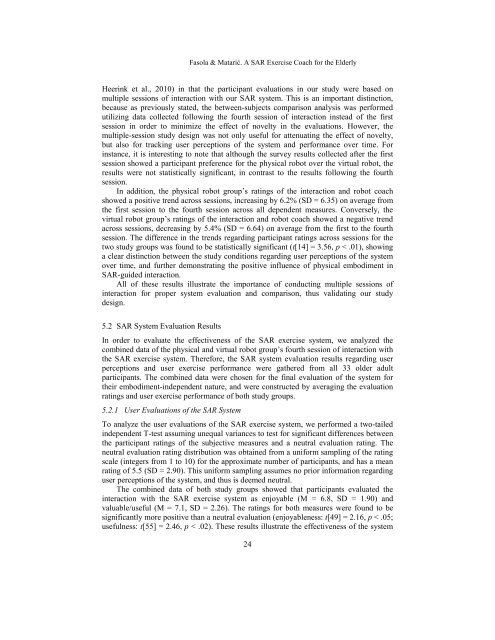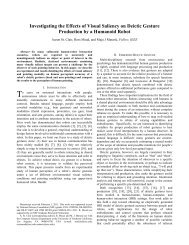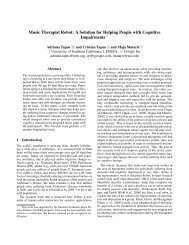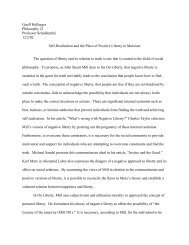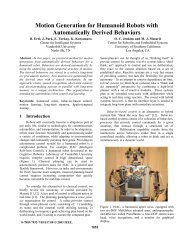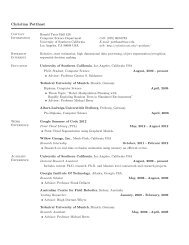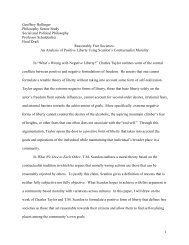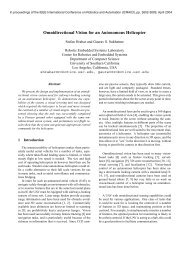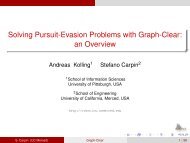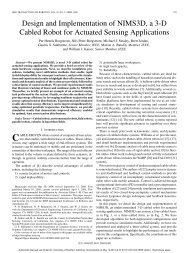A Socially Assistive Robot Exercise Coach for the Elderly
A Socially Assistive Robot Exercise Coach for the Elderly
A Socially Assistive Robot Exercise Coach for the Elderly
You also want an ePaper? Increase the reach of your titles
YUMPU automatically turns print PDFs into web optimized ePapers that Google loves.
Fasola & Matarić. A SAR <strong>Exercise</strong> <strong>Coach</strong> <strong>for</strong> <strong>the</strong> <strong>Elderly</strong>Heerink et al., 2010) in that <strong>the</strong> participant evaluations in our study were based onmultiple sessions of interaction with our SAR system. This is an important distinction,because as previously stated, <strong>the</strong> between-subjects comparison analysis was per<strong>for</strong>medutilizing data collected following <strong>the</strong> fourth session of interaction instead of <strong>the</strong> firstsession in order to minimize <strong>the</strong> effect of novelty in <strong>the</strong> evaluations. However, <strong>the</strong>multiple-session study design was not only useful <strong>for</strong> attenuating <strong>the</strong> effect of novelty,but also <strong>for</strong> tracking user perceptions of <strong>the</strong> system and per<strong>for</strong>mance over time. Forinstance, it is interesting to note that although <strong>the</strong> survey results collected after <strong>the</strong> firstsession showed a participant preference <strong>for</strong> <strong>the</strong> physical robot over <strong>the</strong> virtual robot, <strong>the</strong>results were not statistically significant, in contrast to <strong>the</strong> results following <strong>the</strong> fourthsession.In addition, <strong>the</strong> physical robot group’s ratings of <strong>the</strong> interaction and robot coachshowed a positive trend across sessions, increasing by 6.2% (SD = 6.35) on average from<strong>the</strong> first session to <strong>the</strong> fourth session across all dependent measures. Conversely, <strong>the</strong>virtual robot group’s ratings of <strong>the</strong> interaction and robot coach showed a negative trendacross sessions, decreasing by 5.4% (SD = 6.64) on average from <strong>the</strong> first to <strong>the</strong> fourthsession. The difference in <strong>the</strong> trends regarding participant ratings across sessions <strong>for</strong> <strong>the</strong>two study groups was found to be statistically significant (t[14] = 3.56, p < .01), showinga clear distinction between <strong>the</strong> study conditions regarding user perceptions of <strong>the</strong> systemover time, and fur<strong>the</strong>r demonstrating <strong>the</strong> positive influence of physical embodiment inSAR-guided interaction.All of <strong>the</strong>se results illustrate <strong>the</strong> importance of conducting multiple sessions ofinteraction <strong>for</strong> proper system evaluation and comparison, thus validating our studydesign.5.2 SAR System Evaluation ResultsIn order to evaluate <strong>the</strong> effectiveness of <strong>the</strong> SAR exercise system, we analyzed <strong>the</strong>combined data of <strong>the</strong> physical and virtual robot group’s fourth session of interaction with<strong>the</strong> SAR exercise system. There<strong>for</strong>e, <strong>the</strong> SAR system evaluation results regarding userperceptions and user exercise per<strong>for</strong>mance were ga<strong>the</strong>red from all 33 older adultparticipants. The combined data were chosen <strong>for</strong> <strong>the</strong> final evaluation of <strong>the</strong> system <strong>for</strong><strong>the</strong>ir embodiment-independent nature, and were constructed by averaging <strong>the</strong> evaluationratings and user exercise per<strong>for</strong>mance of both study groups.5.2.1 User Evaluations of <strong>the</strong> SAR SystemTo analyze <strong>the</strong> user evaluations of <strong>the</strong> SAR exercise system, we per<strong>for</strong>med a two-tailedindependent T-test assuming unequal variances to test <strong>for</strong> significant differences between<strong>the</strong> participant ratings of <strong>the</strong> subjective measures and a neutral evaluation rating. Theneutral evaluation rating distribution was obtained from a uni<strong>for</strong>m sampling of <strong>the</strong> ratingscale (integers from 1 to 10) <strong>for</strong> <strong>the</strong> approximate number of participants, and has a meanrating of 5.5 (SD = 2.90). This uni<strong>for</strong>m sampling assumes no prior in<strong>for</strong>mation regardinguser perceptions of <strong>the</strong> system, and thus is deemed neutral.The combined data of both study groups showed that participants evaluated <strong>the</strong>interaction with <strong>the</strong> SAR exercise system as enjoyable (M = 6.8, SD = 1.90) andvaluable/useful (M = 7.1, SD = 2.26). The ratings <strong>for</strong> both measures were found to besignificantly more positive than a neutral evaluation (enjoyableness: t[49] = 2.16, p < .05;usefulness: t[55] = 2.46, p < .02). These results illustrate <strong>the</strong> effectiveness of <strong>the</strong> system24


